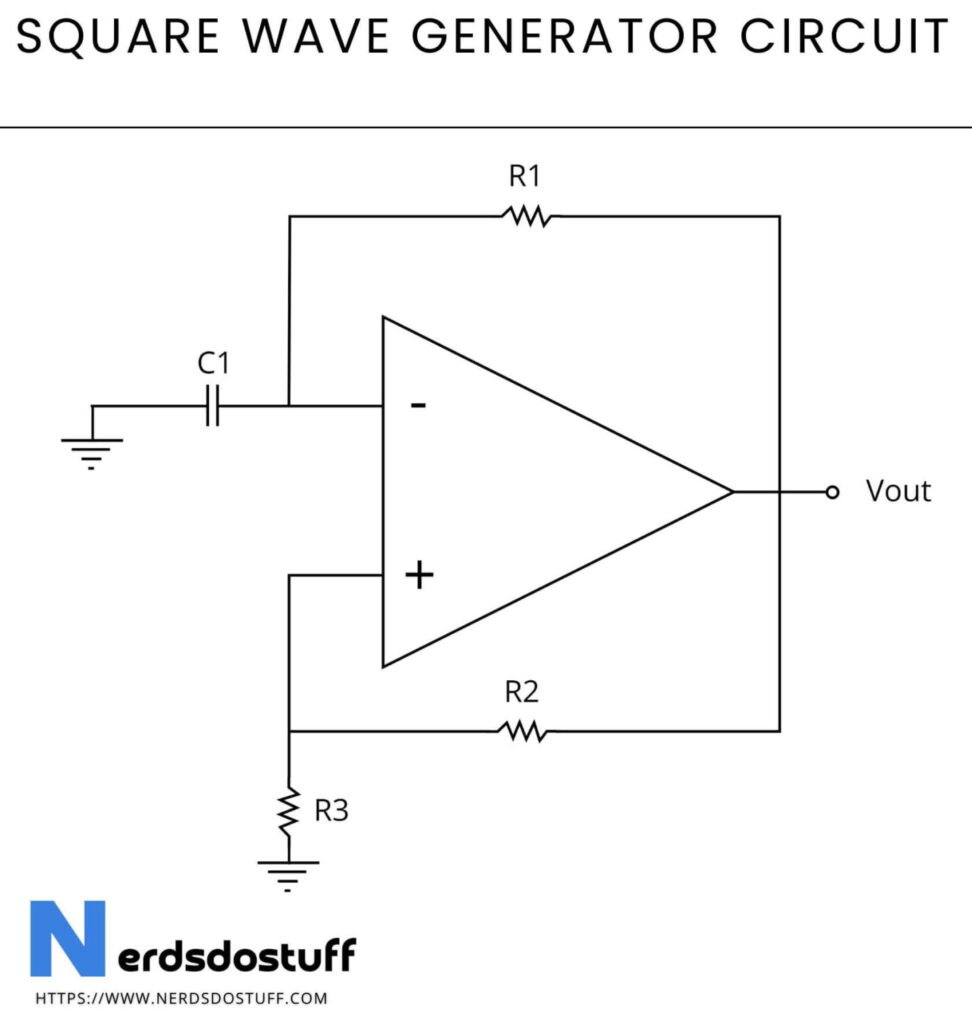What is Square Wave Generator ?
A square wave generator is an electronic circuit or device that produces a square waveform as its output signal. It typically consists of an oscillator circuit that generates a periodic waveform with equal duration high (logic level “1”) and low (logic level “0”) states. The square waveform alternates between these two states at a fixed frequency, resulting in a waveform characterized by sharp transitions between the high and low levels, with equal time spent in each state. Square wave generators are used in electronic systems for applications such as clock signals, digital communication, pulse-width modulation (PWM), and signal generation in testing and measurement equipment.
Square Wave Generator Circuit

Working of Square Wave Generator
In square wave generator, the oscillator circuit generates a continuous oscillation, and a comparator or similar circuitry is employed to convert the continuously varying waveform into a square waveform. When the waveform exceeds a certain threshold voltage, the comparator output switches to the high state, and when it falls below the threshold, the output switches to the low state. This process repeats periodically, resulting in a square waveform with sharp transitions between the high and low levels. The frequency of the square wave is determined by the oscillation frequency of the oscillator circuit, which can be adjusted using external components such as resistors and capacitors.
Characteristics of Square Wave Generator
| Characteristic | Description |
|---|---|
| Output Waveform | Generates a square waveform as its output signal, characterized by sharp transitions between high (logic level “1”) and low (logic level “0”) states. |
| Oscillator Circuit | Typically utilizes an oscillator circuit to generate a periodic waveform, which is then converted into a square waveform. |
| Equal Duration States | Provides equal duration high and low states in the square waveform, resulting in a 50% duty cycle. |
| Frequency Control | The frequency of the square wave can usually be controlled by adjusting the parameters of the oscillator circuit, such as resistors and capacitors. |
| Sharp Transitions | Ensures sharp transitions between the high and low levels of the square waveform, resulting in fast rise and fall times. |
| Applications | Widely used in electronic systems for tasks such as clock generation, digital communication, pulse-width modulation (PWM), and signal generation in testing and measurement equipment. |
Applications of Square Wave Generator
- Clock Generation: Square wave generators are widely used for generating clock signals in digital circuits and systems. Clock signals with precise timing and a stable frequency are essential for synchronizing the operation of digital components in computers, microcontrollers, and other digital devices.
- Digital Communication: Square wave generators are used in digital communication systems for encoding digital data into square waveforms for transmission over communication channels. In serial communication protocols such as UART (Universal Asynchronous Receiver-Transmitter) and SPI (Serial Peripheral Interface), square wave signals are used to represent binary data.
- Pulse-Width Modulation (PWM): Square wave generators are employed in PWM circuits to generate variable-width square wave pulses. PWM signals are commonly used for controlling the speed of motors, the brightness of LEDs, and the power output of amplifiers in applications such as motor control, lighting control, and power electronics.
- Testing and Measurement Equipment: Square wave generators are used in testing and measurement equipment such as oscilloscopes, function generators, and signal generators. They provide standardized square wave signals for calibrating and testing electronic circuits, as well as for generating test signals for functional verification and troubleshooting.
- Signal Conditioning: Square wave generators are used for conditioning signals in various electronic systems. For example, they can be used to generate trigger signals for capturing waveform data on oscilloscopes or to provide timing signals for controlling the operation of electronic systems.
- Frequency Synthesis: Square wave generators can be used in frequency synthesis circuits to generate harmonically related square wave signals at multiple frequencies. This is useful in applications such as RF (radio frequency) signal generation, where precise frequency control and synchronization are required.
- Audio Applications: Square wave generators can be used in audio applications for generating synthetic sounds, tones, or effects. While square waves are not typically used for music synthesis due to their harsh sound, they can be used creatively in electronic music production and sound design.




